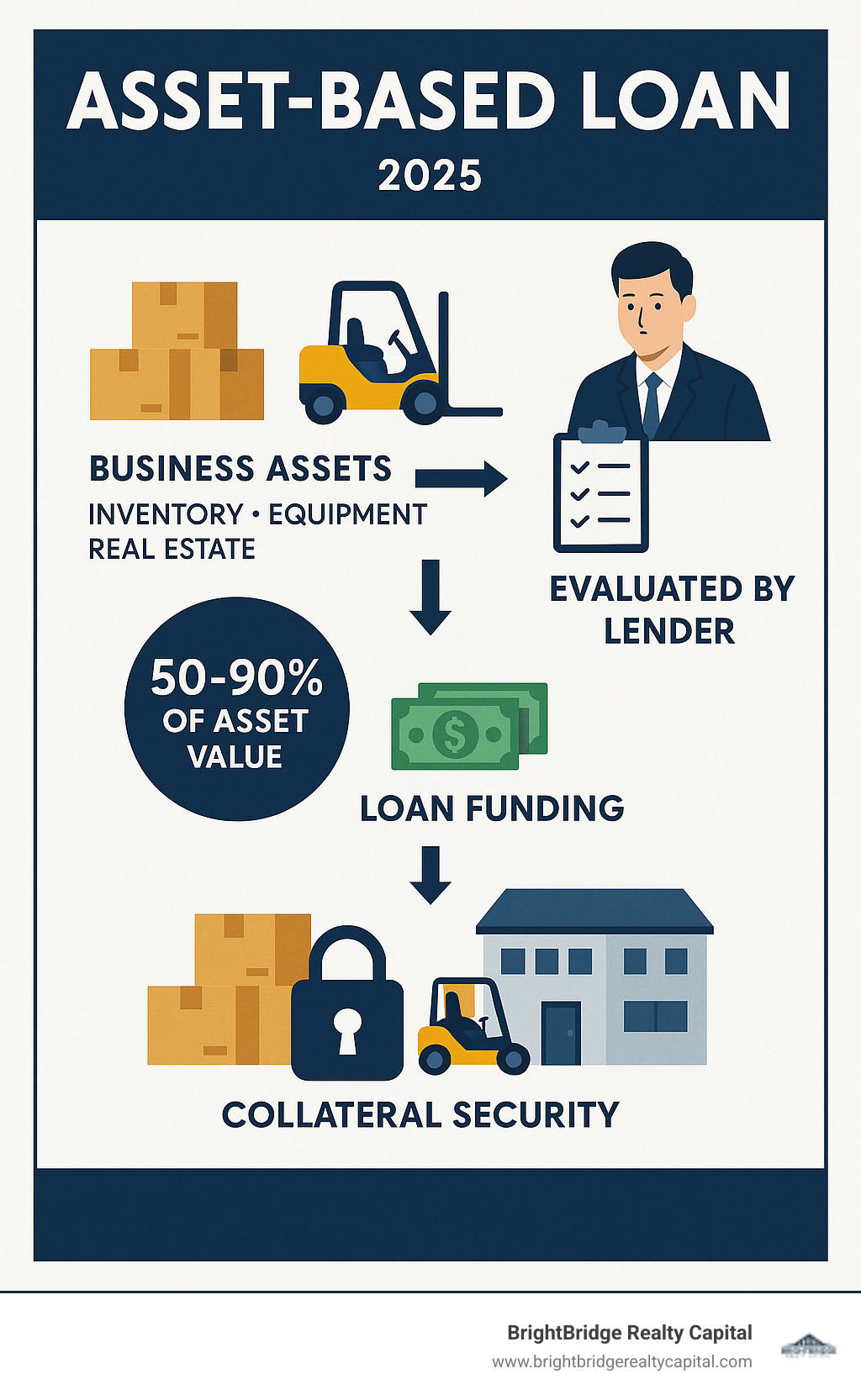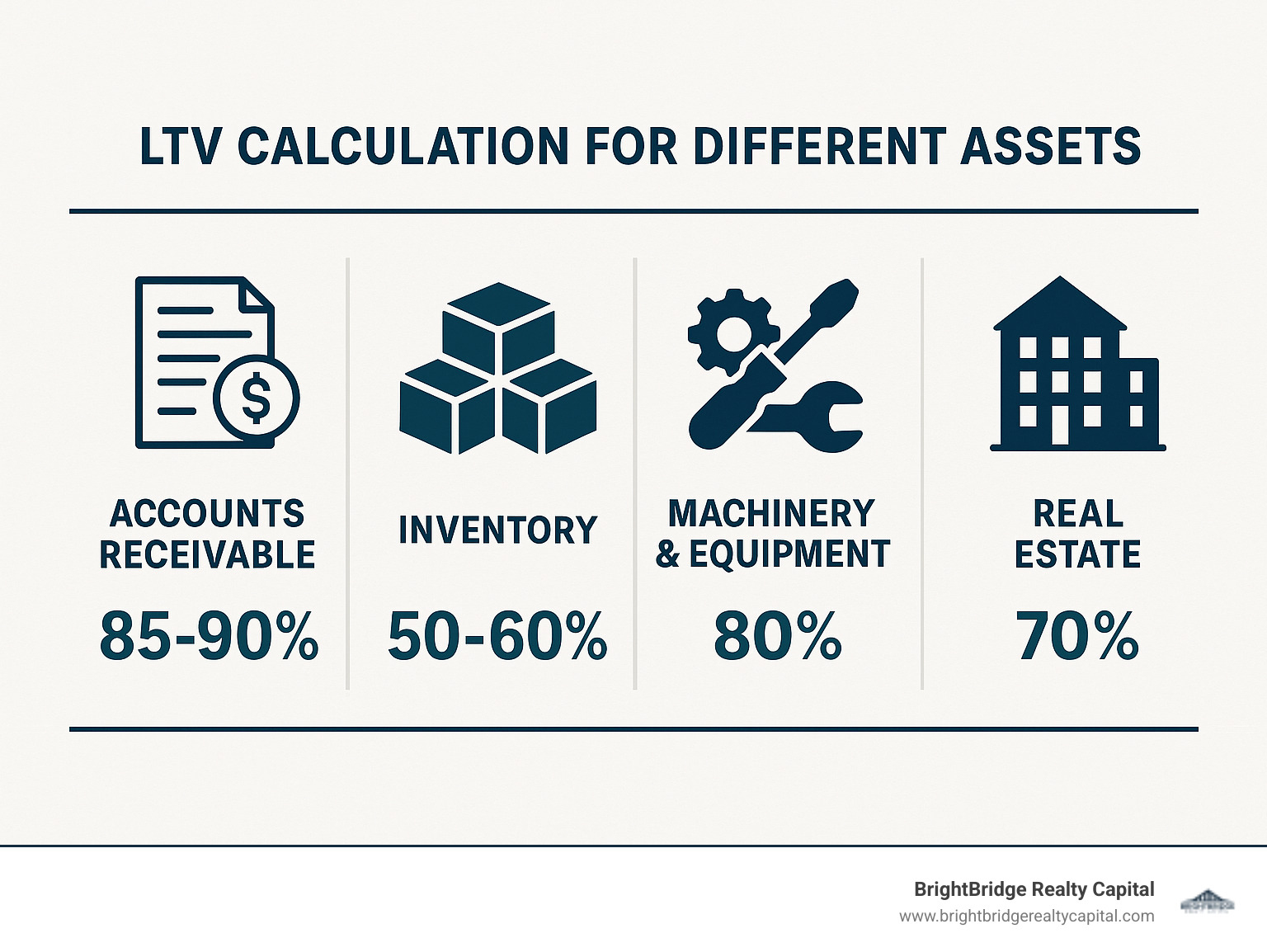What is an Asset-Based Loan and How Does it Work?

Understanding Asset-Based Lending: A Faster Path to Capital
An asset based loan is a secured financing solution where lenders use your business assets—such as inventory, equipment, or real estate—as collateral. Instead of focusing on credit scores or cash flow history, lenders advance 50-90% of your eligible assets' value. This makes it a powerful tool for working capital, growth financing, and real estate investment.
This approach is ideal for business owners and real estate investors who have valuable assets but may not qualify for traditional bank loans due to inconsistent income, limited credit history, or the need for rapid funding. While conventional lenders scrutinize income statements, asset-based lenders care more about what you own. If you default, they can recover their investment by selling the collateral.
The trade-off is straightforward: you gain faster access to capital with more flexible requirements, but you place your business assets at risk and may face higher interest rates than with conventional loans.
As Daniel Lopez from BrightBridge Realty Capital, I've seen how this financing can empower real estate investors to act on time-sensitive opportunities when traditional banks say no.

Quick asset based loan definitions:
What is Asset-Based Lending? A Collateral-First Approach
An asset based loan is a type of financing secured by your company's valuable assets. Instead of focusing on past profits or cash flow, lenders evaluate the quality and value of the collateral you offer. This approach significantly reduces the lender's risk, as they can recover their investment by selling the pledged assets if the loan is not repaid. This makes ABL a lifeline for companies with fluctuating cash flow, new businesses, or imperfect credit.
An asset based loan can be structured as a revolving line of credit or a term loan, providing essential working capital. For a deeper dive into the basics, see this definition of What Is Asset-Based Lending (ABL)?.
How ABL Differs for Businesses vs. Individuals
While the core concept is the same, asset-based lending applies differently to businesses and individuals.
- For Businesses: ABL typically involves commercial assets like accounts receivable, inventory, machinery, and commercial real estate. The financing is custom to support daily operations and growth.
- For Individuals: The concept extends to personal assets, especially in real estate. Mortgages for investors can be structured as asset based loans, which is ideal for self-employed borrowers or retirees with significant assets but low fixed income. A popular option for real estate investors is a DSCR loan, where the property's income-generating potential is the primary qualification factor, not personal income.
Common Types of Asset-Based Loans
Asset-based lending is flexible and comes in several forms to leverage specific assets:
- Revolving Line of Credit: Acts like a business credit card, allowing you to borrow, repay, and borrow again up to a limit determined by your collateral's fluctuating value. This is highly dynamic; as your receivables and inventory grow, so does your access to capital, making it perfect for scaling businesses.
- Term Loans: A lump-sum loan paid back over a set period with regular principal and interest payments, typically secured by long-term assets like machinery, equipment, or real estate. These are ideal for financing specific capital expenditures.
- Accounts Receivable Financing: Borrow against your unpaid invoices to bridge cash flow gaps. Lenders may advance up to 85-90% of eligible receivables. To be considered eligible, invoices must typically be current (not over 90-120 days past due) and owed by creditworthy customers.
- Inventory Financing: Use your inventory as collateral to purchase raw materials or stock up for busy seasons. Lenders typically advance around 50% of the finished inventory's value, with lower rates for raw materials or work-in-progress due to their lower liquidity.
- Equipment Financing: Secure a loan using your existing machinery and equipment as collateral to fund new purchases or open up cash. This can be structured as a term loan or as part of a larger revolving line of credit.
- Real Estate-Backed Loans: Use commercial real estate as powerful collateral to secure significant capital. This is especially useful for investors and can take the form of bridge loans for quick acquisitions or longer-term financing based on the property's value.
How an Asset-Based Loan Works: From Collateral to Capital
The process for securing an asset based loan is more hands-on than a traditional loan because the lender's primary focus is on your assets. It involves valuing, monitoring, and reporting on your collateral throughout the loan's term.

When you apply, the lender conducts thorough due diligence to understand the value and quality of your collateral. This is a critical step that goes far beyond a simple credit check. This includes:
- Field Examinations: Detailed on-site audits conducted by the lender or a third party to verify your financial and physical assets. Examiners review accounting records, A/R aging reports, and inventory listings. They also physically inspect inventory to check for quality, condition, and potential obsolescence, ensuring the assets reported truly exist and hold value.
- Appraisals: Independent experts are hired to determine the fair market value (FMV) or, more commonly, the net orderly liquidation value (NOLV) of assets like real estate and machinery. This valuation is crucial as it directly impacts your borrowing capacity.
- Reporting Requirements: Borrowers must provide frequent (often weekly or monthly) reports on accounts receivable, inventory, and other pledged assets via a "borrowing base certificate." This ongoing monitoring allows lenders to track collateral value in near real-time, offering greater flexibility than a static term loan.
What Assets Can Be Used as Collateral?
An asset based loan is flexible, but some assets are preferred over others. The easier an asset is to value and convert to cash, the more a lender is willing to lend against it.
- Accounts Receivable: Often the most desirable collateral, with advance rates of 85-90% on eligible invoices. Lenders will often impose concentration limits, capping the amount of receivables from a single customer to mitigate risk.
- Inventory: Finished goods are highly leverageable, usually at around 50% of their NOLV. Raw materials and work-in-progress may be included at lower rates, as they are harder to sell in a liquidation scenario.
- Machinery & Equipment (M&E): Can secure a term loan, with lenders advancing up to 80% of the M&E's NOLV. General-purpose equipment holds its value better than highly specialized machinery, which may receive a lower advance rate.
- Real Estate: Commercial properties and investment properties are strong collateral, with advance rates around 70% of the appraised FMV. This is a key advantage for real estate investors, and a DSCR loan is another asset-focused option.
- Other Assets: Less commonly, intellectual property (IP) like patents and trademarks or marketable securities like stocks and bonds may also be used as collateral, though valuing IP can be complex and subjective.
How the Loan Amount is Determined
Your borrowing capacity with an asset based loan is dynamic and tied directly to your collateral's value. Key terms determine your loan amount:
- Borrowing Base: The maximum amount you can borrow at any time, calculated by applying advance rates to your eligible collateral.
- Advance Rates & LTV: The Loan-to-Value (LTV) is the percentage of an asset's value a lender will finance. These percentages, or advance rates, vary by asset type based on risk and liquidity (e.g., 85-90% for receivables, 50-60% for inventory).
- Net Orderly Liquidation Value (NOLV): An estimate of an asset's sale price in a timely, orderly sale, not a fire sale. This is often used for valuing inventory and equipment and is typically lower than fair market value because it assumes a sale under some pressure.
- Asset Quality: Lenders carefully assess the quality of your assets. High-quality assets (e.g., receivables from a diverse base of creditworthy customers) lead to a stronger, more reliable borrowing base.

As your business grows its asset base, your ability to borrow can grow with it, providing scalable financing.
Asset-Based Lending vs. Other Financing: Pros, Cons, and Comparisons
When choosing a funding path, it's crucial to weigh the pros and cons. An asset based loan offers significant flexibility but comes with unique costs and requirements compared to other options. Expect fees for origination, audits, and due diligence, which can make the total cost higher than a traditional bank loan. For a helpful overview, see the SBA's guide: Asset-Based Lending: What is the Upside and Downside?.
Advantages of an Asset-Based Loan
An asset based loan is compelling for businesses that don't fit the traditional bank mold.
- Easier Qualification: Approval is based on collateral value, not just credit history or cash flow, making it accessible for companies with limited credit or fluctuating profits.
- Faster Funding: The focus on asset valuation speeds up the approval process, which is critical for seizing time-sensitive opportunities.
- Flexible Use of Funds: Capital can be used for a wide range of business needs, from working capital to growth initiatives.
- Higher Borrowing Limits: Loan amounts are tied to asset value, often allowing for larger loans than those based on earnings.
- Supports Growth: Your borrowing limit can grow automatically as your asset base expands, providing scalable liquidity.
- Good for Cyclical Businesses: ABL provides a financial cushion during slow periods and allows you to scale up quickly when demand increases.
Disadvantages and Risks
It's equally important to understand the potential downsides of an asset based loan.
- Risk of Asset Seizure: If you default, the lender can seize and sell your pledged assets to recoup their investment.
- Higher Costs: Due to intensive monitoring and administrative work, ABL typically has higher interest rates and fees than traditional loans.
- Intensive Monitoring: Lenders require frequent, detailed reporting on your collateral, which can be an administrative burden.
- Potential for Asset Undervaluation: Lenders use conservative valuations (like NOLV), which may be lower than an asset's book value, potentially reducing your borrowing capacity.
- Not All Assets Qualify: Highly specialized, obsolete, or otherwise risky assets may not be eligible for collateral, limiting your loan amount.
Comparing Asset-Based Lending and Cash Flow Lending
Understanding the difference between ABL and traditional cash flow lending is key. ABL is for asset-rich companies, while cash flow lending suits businesses with stable, predictable profits.
| Feature | Asset-Based Lending (ABL) | Cash Flow Lending (Traditional) |
|---|---|---|
| Evaluation Focus | Primarily on the value and quality of pledged assets (collateral) | Primarily on historical profitability, projected cash flow, and EBITDA |
| Covenants | Often "covenant-light" (fewer financial performance requirements) | More stringent financial covenants (e.g., debt-to-EBITDA ratios) |
| Flexibility | High flexibility; borrowing capacity can grow with assets; funds can be used broadly | Moderate flexibility; fixed loan amounts; use of funds may be restricted |
| Ideal Borrower | Asset-rich companies with fluctuating cash flow, high growth, or in turnaround | Companies with stable, predictable cash flow and strong operating history |
| Underwriting | Focus on collateral valuation, field exams, and ongoing monitoring | Focus on financial statements, credit history, and industry analysis |
If your balance sheet is strong but your income statement is inconsistent, an asset based loan is a powerful solution. If you have steady cash flow and strong credit, a traditional loan might offer lower rates.
Who Uses Asset-Based Loans and Why?
Asset-based lending is a versatile financing tool that is particularly powerful for certain types of businesses and situations.

ABL is an ideal fit for:
- Rapidly growing companies whose success is consuming cash faster than it comes in.
- Undercapitalized businesses that have built valuable assets but lack the cash reserves traditional banks require.
- Companies in turnaround situations that need a lifeline based on what they own, not recent performance. For example, a business emerging from bankruptcy may have a damaged credit profile but still possess valuable machinery and real estate, making it a prime candidate for ABL.
- Seasonal businesses that need financing that flexes with their inventory and cash flow cycles.
- Mergers and acquisitions (M&A) where the combined assets of the acquiring and target companies can be leveraged to finance the transaction itself. This is a common strategy in private equity-backed buyouts.
Common Industries That Rely on ABL
Certain industries are natural fits for asset-based lending due to their asset-heavy models:
- Manufacturing, Wholesale, and Distribution: These businesses have significant, constantly turning inventory and accounts receivable that are perfect for ABL. A manufacturer might use an ABL facility to manage the cash gap between paying for raw materials and getting paid for finished goods.
- Retail: ABL is beneficial for managing large seasonal inventory fluctuations. A retailer can borrow against its inventory to stock up for the holidays and then pay down the line of credit as the inventory is sold.
- Transportation: Companies can leverage valuable fleets of trucks, trailers, and other equipment to secure working capital for fuel, maintenance, and payroll.
- Business Services: Staffing firms or government contractors with substantial accounts receivable can use ABL to manage cash flow while waiting for clients to pay large invoices.
- Real estate investment: This is a key sector for BrightBridge Realty Capital. We leverage property assets for financing, specializing in rental property financing options that use this asset-centric approach.
Typical Use Cases for an Asset-Based Loan
An asset based loan provides flexible capital that can be used for many purposes:
- Working capital to pay suppliers and meet payroll while waiting on customer payments.
- Growth capital to seize new opportunities, such as taking on a large customer or expanding into a new market.
- Debt refinancing to consolidate higher-interest debt into a more manageable loan with a lower total cost of capital.
- Capital expenditures for new equipment, technology, or facility upgrades to improve efficiency or capacity.
- Bridge financing to provide interim funding while waiting for a long-term solution, such as an SBA loan or equity financing.
- Real estate investment projects, a core focus for us, including acquisitions, fix-and-flips, and distressed asset purchases.
Frequently Asked Questions About Asset-Based Lending
Here are answers to some of the most common questions about asset-based lending.
What are the typical eligibility requirements for an asset-based loan?
For an asset based loan, lenders focus primarily on your assets. Key requirements include:
- An Asset-Rich Balance Sheet: You must have sufficient eligible collateral, such as accounts receivable, inventory, equipment, or real estate. Ineligible collateral often includes receivables from foreign customers or related parties, and obsolete or custom-made inventory.
- Quality of Collateral: Assets must be of good quality and easily valued. For example, receivables should be current (under 90 days old), and inventory should be marketable and not obsolete. Lenders will scrutinize the concentration of your receivables to ensure you're not overly reliant on a single customer.
- Reporting Systems: You need reliable internal accounting and control systems to track your assets, as you'll be required to submit regular, accurate reports. A lack of trustworthy reporting can be a deal-breaker.
- Loan Size: ABL is typically for larger loan amounts. While some providers offer loans from $3 million to $35 million, our real estate investor loans can go up to $3 million, with minimums around $100,000.
- Legal Ability to Pledge Assets: Your business must be legally able to use its assets as security for a loan, free from other liens or encumbrances.
While good credit is a plus, the quality of your assets and reporting systems is the most critical factor.
What is a "borrowing base certificate"?
A "borrowing base certificate" is a report, typically submitted weekly or monthly, that details your eligible collateral. It lists your current accounts receivable and inventory, applies the agreed-upon advance rates, and calculates your current borrowing capacity. For example, it would show $500,000 in eligible A/R at an 85% advance rate ($425,000) and $200,000 in eligible inventory at a 50% advance rate ($100,000), for a total borrowing availability of $525,000. This document is the foundation of an asset based loan, allowing the lender to monitor the collateral and ensuring you know how much capital is available to you.
Can I get an asset-based loan with bad credit?
Yes, it is often possible to get an asset based loan with a less-than-perfect credit history. Because the loan is secured by your collateral, lenders focus more on asset quality than on your personal or business credit score. This provides a path to financing for businesses that may not qualify for conventional loans due to past financial struggles.
However, a poor credit history is still a risk factor. While a low score might be overlooked, a history of financial mismanagement, fraud, or bankruptcy could make lenders hesitant. If approved, a borrower with weaker credit may face:
- Lower Advance Rates: You may be offered a lower loan-to-value (LTV) on your assets.
- Higher Interest Rates: The rates may be higher to compensate for the perceived risk.
- More Stringent Terms: The lender might require more frequent reporting, lockbox arrangements for receivables, or stricter loan covenants.
What are the typical interest rates and fees for an asset-based loan?
The cost of an asset based loan is higher than a traditional bank loan due to the increased monitoring and risk. Interest rates are typically variable, quoted as a spread over a benchmark rate like the Prime Rate (e.g., Prime + 2% to 7%). In addition to interest, borrowers should expect several fees, including an origination fee (1-2% of the loan amount), appraisal and field exam fees, and ongoing administrative or unused line fees. It's crucial to evaluate the total cost of capital, not just the interest rate.
Conclusion: Is an Asset-Based Loan Right for You?
Deciding if an asset based loan is the right choice depends on your specific circumstances. This financing option is most powerful when you have valuable assets but face problems with traditional lenders due to unpredictable cash flow, rapid growth, or the need for speed.
The key benefits are easier qualification, faster funding, and higher borrowing limits based on asset value. However, this comes with the trade-offs of putting assets at risk, higher costs, and intensive reporting requirements.
An asset based loan is ideal for:
- Companies with strong balance sheets but inconsistent income.
- Rapidly growing businesses that are cash-constrained.
- Real estate investors who need to close deals quickly.
- Businesses in turnaround situations.
At BrightBridge Realty Capital, we see how the right financing transforms an investor's ability to act on opportunities. Whether you need to explore fix and flip financing solutions or require quick capital for an acquisition, understanding your options is key.
If you have valuable assets, need flexible capital, and can manage the reporting, an asset based loan could be the perfect tool to fuel your growth. The best financing decision aligns with your goals, timeline, and risk tolerance.


